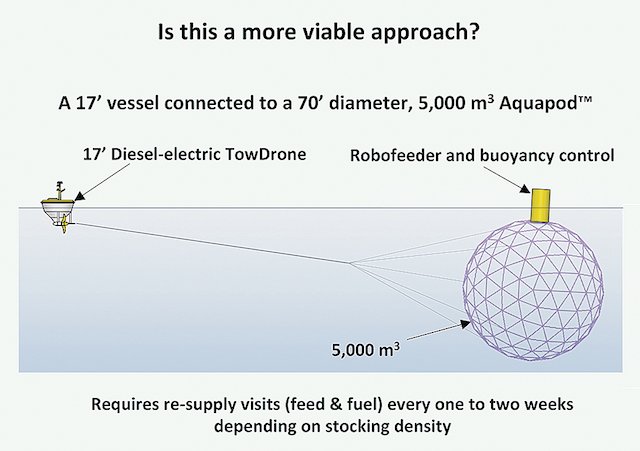
Scientists see role for robots in mariculture
March 3, 2016
By Erich Luening
 AUVs such as this 17’ diesel-electric TowDrone could someday replace towboats in towing cages Reduced man-hours and costs could be among the benefits of using ‘aquabots’
AUVs such as this 17’ diesel-electric TowDrone could someday replace towboats in towing cages Reduced man-hours and costs could be among the benefits of using ‘aquabots’Scientists are exploring the potential of robotics in addressing the challenges in open-ocean mariculture, which include high man-hour requirements and high maintenance costs.
At a workshop in January, researchers at the Woods Hole Oceanographic Institute and Marine Biology Labs (MBL) explored the potential of robotics and autonomous underwater vehicles (AUVs) for mariculture application.
Technologies presented ranged from sleek, autonomously operated torpedo-like platforms to high-tech miniaturized laboratories to parasite-zapping lasers.
Commercial and government representatives were in attendance at the workshop held at the Quissett Campus in Cape Cod, Massachusetts. Their presence highlighted the interest in this growing sector, the challenges faced by farmers, and the need for new technology to meet those challenges.
“It was a good meeting with an interesting mix of offshore aquaculture people needing solutions to problems, and ocean robotics experts looking for applications for their robots,” Michael Rust, National Oceanic and Atmospheric Administration (NOAA) aquaculture science coordinator, told Aquaculture North America after the workshop.
Participants acknowledged that one of the challenges of farming fish in open-ocean pens roughly 50 miles out to sea is the cost and man-hours necessary to maintain the technology and the fish.
“There are certainly going to be aquabots in the future of marine aquaculture, but it will take both camps working together to get there in the near future with products that are robust, cost-effective and transformational,” he said. “The key will be finding a way to provide benefits greater than the costs to purchase and keep them going and focusing on those hard-to-solve-any-other-way problems.”
One presentation highlighted a new software that could assist “aquabots” in deciding what to do and when, using spatial and pattern recognition to identify anomalies in regular patterns.
Yogesh Girdhar, a post-doctoral researcher at WHOI, presented video of a small flapping underwater vehicle, which, by using the software was able to identify differences on a coral reef it had been surveying.
Girdhar called it a “curious robot” and explained the software he developed could help robots or AUVs also identify dead fish at the bottom of a pen, feed distribution, or even holes in the cage, and notify workers onshore.
“Fish farmers could use a ‘smart’ robot instead of hundreds of cameras and hydrophones, or use it in collaboration with the other technology,” he said.
Outlook
Participants acknowledged that a lot of what is on the shelf at WHOI and other oceanographic robotics labs, such as the Monterey Bay Aquarium Research Institute, may be too costly for startups, or fledgling open-ocean mariculture companies to adopt.
That said, the existing AUV and robotics commercial industry may be able to bridge that gap until cheaper technologies from the researchers and developers at the institutes become available.
A number of companies have small, yet affordable, solutions that may address some challenges open-ocean fish farms face.
Remotely operated vehicles (ROVs), like Teledyne SeaBotix’s LBV platform, are on the market but their products have limitations, including requiring operators on the surface. While others offer small AUVs that currently sell in the defense, oceanographic, and energy sectors, makers like Bluefin Robotics and Riptide Autonomous Solutions claim they can serve marine fish farmers as well.
Hauke Kite-Powell, the aquaculture research specialist at WHOI’s Marine Policy Center, believes there are pros and cons to farming fish in open-ocean pens, and robotics and autonomous vehicles can make an impact on its success.
He also said that some of the challenges marine fish farmers may face, like exposure, logistics, mooring at deep water depths and adverse working conditions, could be met by robotics technologies once they come on to market.
— Erich Luening





